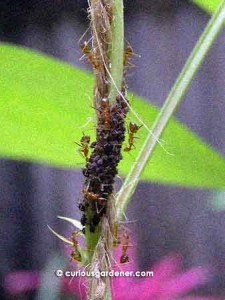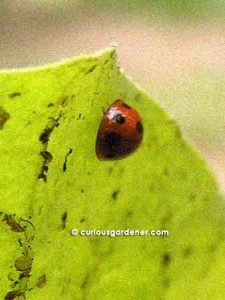I’m beginning to get a sense of dread whenever I see excited ants clustered on my plants. First it was the black ants all agog over the mealy bug infestation on my fastest-growing Red Lady papaya tree. Yes, I know the insects secrete a kind of nectar that the ants enjoy, but I sure didn’t reciprocate the enjoyment at all. The infestation was so bad that I got rid of the plant just to get rid of the mealy bugs.
So, when I saw large orange ants (thankfully not kerenga fire ants) in a cluster along the stem of one of my long bean plants last week, my pulse rate faltered then sped up. What now? They were way more excited than they normally are when the plants begin to flower.

Up close and personal with black aphids. They're that fat because they've fed off sap from the plant stem. :(
Closer inspection revealed something black that had a very lumpy surface. I did not like that one bit. It turned out to be a colony of black aphids that seemed to like the home provided by the rough strands of the twine that the long bean stem was wound around, and that their food – the stem – was so close at hand. My protective streak overrode all else, and I got the insecticide and sprayed, carefully, the twine, so that it soaked up the liquid to make it less attractive to the aphids. The ants dispersed hurriedly once they got the scent, but the aphids just stayed there. Mindful that the plant does need other insects to come by to pollinate the flowers, I didn’t spray a lot, just hoping that the dose I’d given would make them lose interest, or at least die a slow, painful death. ![]()
Early the following day, I found that there were still some aphids left, so I mentally braced myself and removed the soft, squishy insects by hand. I did not enjoy that experience at all.
A few days later, there were a couple more clusters on the next vine. Again, I sprayed the twine.
Note to self: better stop using twine if it attracts aphids!
Again, the following day, I removed the remaining aphids by hand. While I was doing that, something caught my eye. I have a few potted brinjal plants growing just in front of the trellis. There, on the edge of the underside of one of the leaves, was a bright red dot … a ladybug!
This is the first time that the principle of beneficial insects coming to the garden because the pests (their food) are there has happened to me! At least, I assume it was there because of the aphids. I’ve been adding other flowering plants in the vicinity as an invitation to beneficial insects, but they’re not in full bloom yet. It had to be the aphids that brought it there, right?
I immediately put the insecticide aside. Hopefully, it won’t chase off the ladybug, or worse, harm it. Of course, this means I have to be hands-off where the aphids are concerned, and leave their management to the ladybug(s). If the ladybug was there because of the aphids then I can say I’ve never been so happy to have aphids around!
© 2011 curiousgardener.com All rights reserved.



I adore ladybugs! Maybe one day you’ll catch it in action and see it om-nom-noming on the aphids. =3
Heh, I’d like to see that! Better yet, I’d like to see ladybugs more often. There seemed to be many more when I was younger. Wonder why their population has dropped?
Better yet, I’d like to see ladybugs more often. There seemed to be many more when I was younger. Wonder why their population has dropped?
Too much pesticide and chemicals used everywhere, methinks…sighs…
Plus climate change, more built up land, insufficient attractive plants for them… Funny how we want the ladybugs while in other parts of the world they’re considered pests!
I guess when anything becomes too many and is disruptive then they are considered pests…lol.
Ain’t that the truth! Think my edible plants can become nuisances? LOL
If you don’t want them anymore then they are…lol.
Would reverse psychology work?
I dunno!
I’d probably end up with a garden of weeds if I tried! Ah well, hope the plants grow and bloom, and lure the ladybugs here. Fingers crossed!
I just read this in a gardening community on Livejournal today:
“Knowing what ladybugs and their larvae eat is the first step to inviting them into your garden. Ladybugs, besides eating aphids and whiteflies, also eat pollen. Their favorite pollens are dill, cilantro, yarrow, wild carrot, angelica, cosmos, geraniums and dandelions (or so common knowledge says — if you have seen a ladybug ‘favor’ a plant, let me know!). Planting these in your garden, near plants that regularly have pest problems, like tomatoes, cucumbers, radishes, etc, should attract ladybugs to your target plants. But remember: if you want ladybugs, you need to have aphids!”
Hope that helps!
Yup, have been interspersing more flowers with the veggies, but since they haven’t started flowering yet, I can’t gauge how effective they are/will be. Thought I saw a small ladybug on the long bean plant this morning, though! 8)